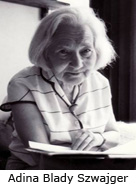
In the Face of Death: I Killed All the Children
Scenario 1: The Warsaw Ghetto Doctor
In the late summer of 1942, 22 year old Adina Blady Szwajger was working as a doctor
at Warsaw's Children's Hospital. It was no ordinary summer, though. Some 18 mnonths
earlier, the Nazi occupiers of Poland had shut the gates on Warsaw's Jewish population
creating what is now known as the Warsaw ghetto. As a result, Szwajger had for at
least a year worked in conditions of almost unimaginable suffering as the hospital
filled with children dying of starvation and tuberculosis. In her memoir, she talks
of "famished skeletons" lapping up the slops of a spilled soup pot from the floor;
and of the attempt to live a "principled life" in circumstances of the utmost moral
depravity.
But in August 1942, it became impossible to go on. The Germans had begun to round
up the Jewish population, loading them into cattle trucks and shipping them off
to the death camps, where their fate was to meet a grisly end. By this point, the
hospital was no longer functioning as a hospital - there were "no children's wards,
just the sick, the wounded and the dying everywhere."

The moment which came to define Szwajger's life arrived when the Nazis turned up
at the hospital, and began the brutal process of shutting it down. A nurse begged
Szwajger to end her elderly mother's life: "Doctor...I can't do it. I beg you, please.
I don't want them to shoot her in bed, and she can't walk." Dr. Szwajger administered
morphine, first attending to "families of staff." Then she went to the ward which
housed the smallest infants, and one by one gave each child a lethal dose. "Just
as, during those two years of real work in the hospital, I had bent down over the
little beds, so now I poured this last medicine into those tiny mouths...And downstairs,
there was screaming because the...Germans were already there, taking the sick from
the wards to the cattle trucks." She told the older children "that this medicine
was going to make their pain disappear...So they lay down and after a few minutes
- I don't know how many - but the next time I went into that room, they were asleep."
Adina Szwajger took the lives of her young patients as the final act of what she
saw as her duty of care, in order to spare them ignominious and certain death at
the hands of the Nazis. But, of course, the infants and children did not and could
not have consented. The issue, then, is whether she did the right thing. Was she
morally justified in taking the lives of her patients in order to save them from
their fate at the hands of the Nazis?
Please make a choice!
Please indicate how confident you are about the judgement you've made above.
Please make a choice!